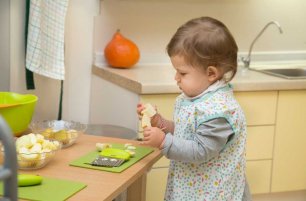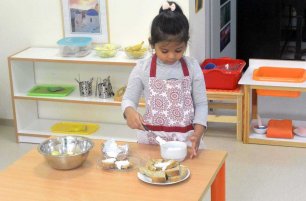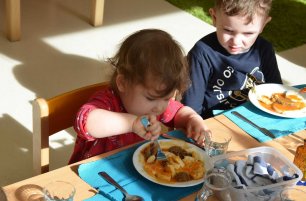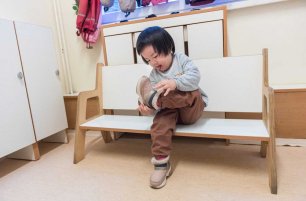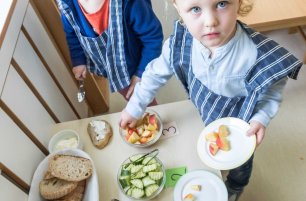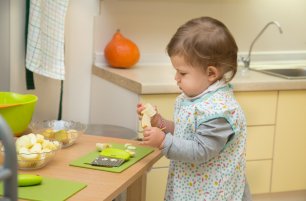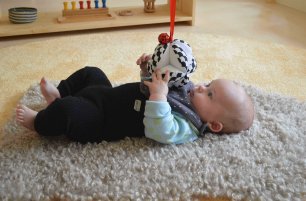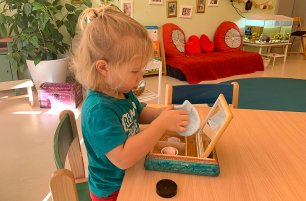The Independent Child
Why - and how - we nurture independence in our students
In Montessori education, children’s independence is one of our most important values. We encourage physical indepence through the „Practical Life“ curriculum from earliest childhood. In pursuit of social and emotional independence, we practice mindful self-awareness and conflict resolution, and teach specific „Grace and Courtesy“ lessons. And, of course, our entire educational approach is built on enabling mental independence by giving children choices and control over their own learning.
Dr. Montessori saw the entire human childhood as a quest for the ultimate independence of productive adulthood. We start out as helpless, defenseless infants and gradually learn how to meet our needs, from the most basic (like crawling and walking to get from place to place without relying on others to carry us) to the sophisticated (like choosing a career path and becoming financially independent).

We believe that there is a straight line from early accomplishments – a preschooler tying their shoes instead of having to ask dad – to the later ones. Independence is not something that turns on once a child reaches a certain age or level of maturity. It‘s a habit that builds up. It’s a form of trust in oneself, a belief in our own capabilities in the world – an „I can do it“ attitude that must be practiced and repeated to form a solid basis of the person’s lifelong personality.
Because independent children don’t turn to adults as often for help or permission, some parents might fear that an overemphasis on independence might make their child disobedient, rude, or careless. But giving children independence goes hand-in-hand with giving them clear boundaries and limits. This includes teaching and showing the child how their actions affect others; that independence isn’t aloneness, and that one of the best thing about learning to meet our own needs is that it also gives us the capacity to cooperate with, and take care of, others.
The trick is in continually growing the child’s freedom, and adjusting their boundaries, in a way that is age-appropriate: offering enough to stimulate but not to overwhelm. It’s the Goldilocks problem: the underestimated child is just as unhappy as the one who is stressed by undue demands; the child who is challenged just enough feels confident, strong and respected.
There’s no calendar stating at which age should a child be ready to do something for themselves. And before they’ll be ready to do things independently, they should have the opportunity to watch how it’s done, and then participate in it without being wholly responsible for the outcome; for instance, you will spend time showing a toddler how to pull on their shirt and helping her do it long before you can expect her to dress herself
We do, however, have a basic rule to do with children’s independence: to not interfere or offer help before it is welcome. “Never help a child with a task at which he feels he can succeed,” wrote Dr. Montessori. Even if you can see something is not going well, even if you know you could do it more efficiently (of course you could!). Sometimes it is a matter of waiting until your child is ready to ask for your help; sometimes you will see them manage and realize you underestimated their abilities.

That said, some of the common acts of independence that we expect of young children are the following:
-
Feeding oneself. An older baby or toddler who can sit at a table is old enough to put their food in their own mouth! You will be surprised by how quickly they learn to even spoon soup if given the chance to practice. By a year or so, most children need no more help than cutting up their food with a knife.
-
Getting dressed. As soon as they can sit, infants can help with their clothes, but the real work starts when they can stand up and walk. Start small – have a child pull on a hat, slide their foot into a shoe, or pull up pants after you have guided their legs inside. With practice and encouragement, a two year old is fully capable of dressing themselves completely, pants, coat, boots and all. During the toddler years, look for clothes with oversized, easy clasps and closures - like velcro shoes instead of shoelaces.
-
Washing up. A two year old child should be able to efficiently wash their hands, brush their teeth, or clean their face after eating; of course, they will have started practicing as soon as they could stand on a stool to reach a sink.
-
Cleaning up. A child who can carry a toy is a child who can put it away when they’ve finished playing. To make it easier, keep shelves organized and not overwhelming – so that it is clear where things belong. Other things a toddler can put away are clothes (at least to the hamper), dirty dishes at the end of the meal, or groceries after shopping. A preschooler should help you run the laundry, wash the dishes or dust and organize the shelves, too; an elementary aged child can then take care of it on their own.
-
Preparing food. Toddlers are enthusiastic helpers in the kitchen and, if given the opportunity, happily learn how to mix, knead, pour, peel, slice and more. By preschool, a child can be expected to make themselves a snack out of known approved options, and an elementary student to make a simple meal or pack themselves a lunch box for the day.
Of course, sometimes you‘ll do something for your child even though they could manage by themselves – after all, taking care of one another is a natural way for human beings to show affection. Whether you brush your daughter’s hair or prepare your son’s lunch box for him, you are not taking away from their independence by this small act of caregiving – as long as you don’t make it a daily occurence. It is all too easy to fall into a habit of doing things for our children, so remember: independence itself is a gift and a powerful demonstration of your love.
by Michaela Tučková
Want to learn more? Read our next article:
IMSP TODDLERS: HELP ME TO DO IT MYSELF
